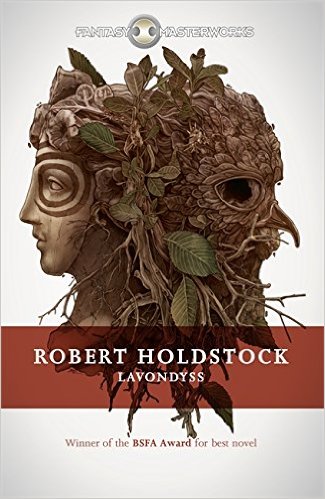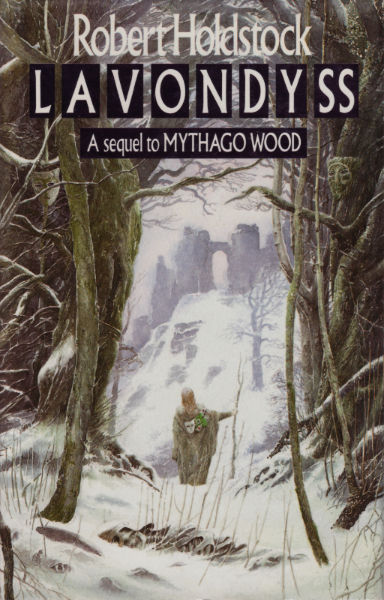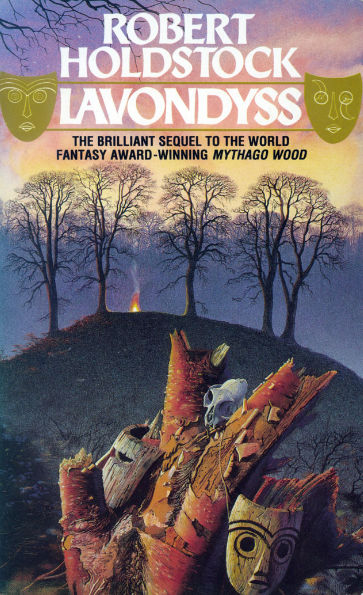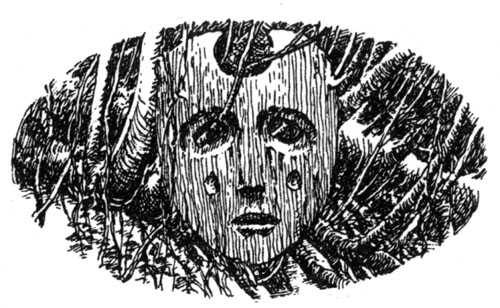Whenever I read Mythago Wood, I vow to work my way through the whole of the Ryhope Wood series. Then I read Lavondyss and stall. This isn’t because Lavondyss is a very different kind of tale from the straightforward fantasy-adventure narrative that drives Mythago Wood — I like the fact Holdstock sets out to do something different in the second book of the series. It’s more to do with a contrast within the book itself. Lavondyss in its second half is a very different book from Lavondyss in its first, and it’s the jarring jump between the two halves that has, until now, always succeeded in putting me off. On this most recent read, though, I finally realised how powerful a novel Lavondyss is, and how it’s actually doing everything Mythago Wood does, only deeper, and weirder, and far more unrelenting in its exploration of what myths are for, and the very human forces that lead to their creation.
Lavondyss is the story of Tallis Keeton, the younger half-sister to Harry Keeton, the airman who accompanied Steven Huxley into Ryhope Wood in the first book, seeking a mythical place he believed could be found deep within the wood, where his facial burns would be healed. The book starts with the disappearance of Tallis’s grandfather, who leaves his baby granddaughter a hastily scrawled and (from the point of view of Tallis’s parents, anyway) rather disturbing letter about stories and myths and the strange powers of nearby Ryhope Wood, before walking out into the snow and dying. Tallis’s later childhood is marked by a second loss when her half-brother Harry’s plane is shot down during the Second World War, and he’s at first believed to be dead. Even when he returns, it’s only briefly, before he sets off on a quest into the depths of Ryhope Wood with Steven Huxley. Lost, then recovered, then lost again.
Tallis vows to go into the wood and bring Harry back. Before she can do this, though, she must complete her education in the strange wood and its ways, learning its stories and the secret names of the fields, stones, trees and pathways that she’ll have to use to enter it. Guided by a trio of hooded, masked women who emerge like shadows from the trees to whisper fragmentary tales, Tallis — who in this first half of the book resembles the semi-feral young girl from Arthur Machen’s “The White People” — is basically undergoing a shamanic initiation into the ways of working a mythago-rich world. Under the three women’s guidance, Tallis makes masks and dolls, and learns to use them to open ‘Hollowings’ into the mythago-reality that surrounds Ryhope Wood.
When a book starts with the initiation and education of a young woman into the secret magic world surrounding her, and with her learning to master her own burgeoning power to interact with and control that secret magic, you can’t help but expect a coming-of-age narrative, a sort of twiggy, muddy Harry Potter with masks instead of wands and a vast, stinking, bellowing monster stag called Broken Boy instead of Hedwig the Owl. But once Tallis enters the wood (sooner than she’d hoped for, and breaking a promise to her father as she does), the book jumps ten years, and when we next see her, she’s a grown woman, scarred, lost, and carrying the remains of her dead child.
 This is no coming-of-age tale. It’s a book about what (it’s suddenly obvious) Mythago Wood was also about, only, with that book, it was easy not to see it because of the wonder of entering the depths of Ryhope Wood for the first time, and the danger and excitement of that brother-versus-brother adventure story. Both are books about loss, and in its second half Lavondyss is relentless in its exploration of loss, broken promises, and failed intentions. And if you think about it you can see that loss is rooted deep in the very idea of the Ryhope Wood books, in the idea of the mythagos themselves, for mythagos are the ghosts of myths: the lingering never-never remnants of the desperate hopes of past ages. In Lavondyss, mythagos are what remain after the loss of loved ones, or the loss of hope. But mythagos offer no comfort. They’re too brutal and strange. (Still, the humans cling to them as a way to undo loss, by remaking, in mythago-form, what was lost — as with Christian Huxley, in Mythago Wood, journeying into Ryhope in search of a new version of his dead mythago wife Guiwenneth, or, in this book, the half-mythago Morthen saying, after she loses her brother and first love: ‘He’s dead… Now I shall return to my father. From his own first forest I shall find my brother once again…’ But it’s always a forlorn and futile hope.)
This is no coming-of-age tale. It’s a book about what (it’s suddenly obvious) Mythago Wood was also about, only, with that book, it was easy not to see it because of the wonder of entering the depths of Ryhope Wood for the first time, and the danger and excitement of that brother-versus-brother adventure story. Both are books about loss, and in its second half Lavondyss is relentless in its exploration of loss, broken promises, and failed intentions. And if you think about it you can see that loss is rooted deep in the very idea of the Ryhope Wood books, in the idea of the mythagos themselves, for mythagos are the ghosts of myths: the lingering never-never remnants of the desperate hopes of past ages. In Lavondyss, mythagos are what remain after the loss of loved ones, or the loss of hope. But mythagos offer no comfort. They’re too brutal and strange. (Still, the humans cling to them as a way to undo loss, by remaking, in mythago-form, what was lost — as with Christian Huxley, in Mythago Wood, journeying into Ryhope in search of a new version of his dead mythago wife Guiwenneth, or, in this book, the half-mythago Morthen saying, after she loses her brother and first love: ‘He’s dead… Now I shall return to my father. From his own first forest I shall find my brother once again…’ But it’s always a forlorn and futile hope.)
Lavondyss is also about art. Tallis’s shamanic initiation can be seen as the birth of an artist. What Tallis-as-artist must understand is that the stories she learns aren’t playthings, but sacred truths which have to be treated with reverence. Speaking of her cache of folklore, she says:
‘It all belongs to me, yes. But it has been passed on to me by someone… Someone else owned the stories first. I mustn’t try to tamper with them. They’re only partly mine, and in any case they are only mine for a while…’
The contrast between art that is treated with reverence — with ‘the unknowing knowing that is at the heart of magic’ — and the latterday remnants that litter the culture with hollow relics of once-true tales, is brought out in the folk rituals of Tallis’s home village:
‘There is no magic left in the festive practices of Oxford, or Grimley, or whatever — the Morrismen and Mummers — no magic unless the mind that enacts the festival has a gate opened to the first forest…’
That ‘first forest’ is Lavondyss, ‘the unknown region’, ‘the place where the spirit of man is no longer tied to the seasons’, ‘the way home’, the depths of the human mind. It is:
‘…both the desired realm, or the most feared realm; the beginning place or the final place; the place of life before birth, or life after death; the place of no hardship, or the place where life is tested and transition from one state of being to another is accomplished. Such a realm would appear to exist in the heartwoods…’
For Harry Keeton, it’s a place of healing, but it’s not going to heal him simply by removing his scars. It’s not a place you come away from without being utterly changed. It’s a place where you must be unmade before you can be remade. It’s where myths are born, and myths aren’t created by human beings when they’re happy. They’re created out of situations of desperation, and it’s just such a situation that we see when Tallis finally finds her way there.
After which she says:
‘I feel violated, consumed; yet I feel loved.’
And it’s far easier to feel that ‘violated’ and ‘consumed’ than it is to feel the ‘loved’.
Lavondyss is a far more challenging book than I had expected the first few times I read it. The signs for the sort of book it is are certainly there in Mythago Wood, but it wasn’t till now, on what must be my third or fourth read, that I’ve finally been able to see them. Now I can see it’s a book that’s more similar to, say, Alan Garner’s Red Shift, or J G Ballard’s The Atrocity Exhibition, than the sort of fantasy book I was expecting.
And that’s certainly set me up for going ahead with the other books in the series. The question is, having taken his series so quickly to such heights of intensity, where can Holdstock go from here?




Sounds intriguing. In terms of the book’s themes, Mythago Wood seems to share many of the properties of fairyland – an unreliable realm into which people can disappear, only to be many years older when they return – if they return at all.
You say ‘Lavondyss is also about art.’ Maybe Holdstock is also trying to address the role of the visual artist – historically – in giving shape and form to popular myths? First you have the author, the story-teller, then you have the paintings, sculptures which illustrate that story, and colour people’s interpretations of it.
Think I might check it out either way!
You’re absolutely right about the Mythago Wood being like fairyland. It comes across much stronger in this book than in the previous one, how involvement with the Mythago Wood changes you deeply and irreversibly.
A shame Robert Holdstock died in 2009. I love these books more than any others.